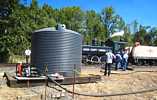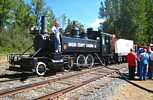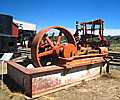Trip to Willits, California
for
Roots of Motive Power
September 8, 2012
 Frank King |
 Bill Newman |

Stan Paddock Organizer |
 Ed Thelen |
This was a recon trip for me, had fun, didn't try to do a comprehensive report. This report shows maybe 25 percent of the interesting stuff.
We started out from Fremont at about 7:30 AM with only 2 GPSs. but we found our way north on 880 and 101 anyway :-)) Parking was convenient and in we went - via some back way, but admission was free anyway ;-))
Maybe 200 meters away we saw a steam shovel ( you know, like dug the Panama Canal ) and Bill Newman quickly left us in his dust.
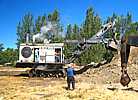
|
The sign on the side says
ERIE EVANSVILLE IND
| 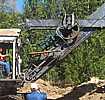
Bill was especially interested in that shiny green assembly on the main boom. It appeared to
vent steam at the far end of the boom
| |
We wandered past various steam cranes, one active, and misc stuff.
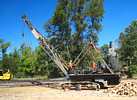
|
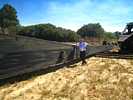
|
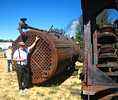
|
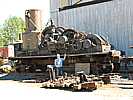
|
Then we wandered into the north end of a huge sheet metal building labeled "ROOTS".

| How is this for different? For reasons I didn't understand, many locomotives for the timbering industry are equipped with gears. Several different manufacturers, several piston/cylinder configurations, all with gears.1. |
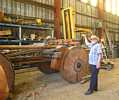
| This vehicle is pretty much "green" made of "sustainable" materials. It looks very old, heavy, and made before "green" was in ?? |

| Very popular stuff ;-)) |
I have always liked electrical stuff, and there was plenty about :-)) Here are parts a large disassembled machine
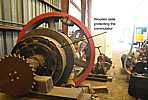
| This is the rotor of a large Direct Current motor or generator. Oddly, the same machine can do either or both ;-)) | 
| Bill Newman provides human interest and a size reference
to one half of a stator that may match the rotor on the left.

diagram from here
Large DC machines frequently use extra wires and poles to counteract the effect of
the current in the rotor which causes an offset magnetic field, which interferes
with commutation.
|
This particular machine uses commutating poles (magnetized by the armature current)
but not compensating winding on the main pole faces.
|
In this area, generators were driven by steam pistons, not steam turbines.
| |
Leaving the south end of the huge "ROOTS" building - and past a railroad bar car - no free drinks ;-(( We entered a field of Boilers and Steam Engines -
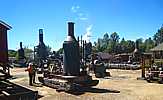
|
With a moving steam locomotive and train in the background :-))
All of the units are skid mounted. |

| Bill feeds the beast. |
One of the units in this field had this sign
At the south end of this field was large steam engine use a very variable speed transmission/governor to provide a widely variable speed to its load - apparently a plywood log peeler - which needs to keep a constant cutting speed while reducing the radius of the log.
We circled back to the west side of the huge "ROOTS" building where one of the rail cranes had de-railed (the two wheels on one axel of one "truck" had skipped off). Stan and Bill had seen the successful efforts to get the wheels of that axel back to normal. Life was so interesting that I didn't take any pictures in that area.
We went across the street to see a few gasoline engines and at faire area with Steampunks. Oddly, Stan said he felt uncomfortable with the oddly dressed people - even though a number of women wore corsets as "tops"2.
| 1 |
from E. J. Thelen
> For reasons I didn't understand, many locomotives for the timbering industry > are equipped with gears. Several different manufacturers, several piston/cylinder > configurations, all with gears. There were three popular locomotives in the Western US timber industry; the Climax (shown in your trip report), the Heisler, and the Shay. They were all designed for steeper rails than most other locomotives (cable cars and funicular railways being notable exceptions, although they donít use locomotives so much as stationary engines to run their cables). I recall that most locomotives canít haul much up a slope greater than 2 or 3%, but these locomotives could handle 5 or 6% grades with ease. Of course, the heavy loads were going downhill, but empty cars could be hauled up really steep grades with these locomotives. The gearing allowed for better hauling capability on the steep tracks, but prevented high speed travel on flat track, sort of like a car or truck in first gear; maximum speed was around 15 mph. Generally, these locomotives were used to get the logs out of the hills and onto flatter ground, and if the logs had to travel by rail to the mill, then often another locomotive would haul them on the flatter terrain. The gearing may have also assisted in sharper turning track than most railroads, and most or all of the wheels could be powered. Most steam locomotives only power the large wheels in the middle of the locomotive and leave the trucks at the front and under the cab as unpowered and are used to help guide the locomotive around curves.
http://en.wikipedia.org/wiki/Climax_locomotive
The Shay was popular because of its ability to travel on poor quality (rapidly constructed or poorly maintained) track. It was said that if you scratched two lines in the ground, a Shay could follow them. However, I donít know of any tests of that saying. I think that the Roaring Camp Railroad in Felton has a Shay and a Climax. |
| 2 |
from E. J. Thelen
> Oddly, Stan said he felt uncomfortable with the oddly dressed people - even > though a number of women wore corsets as "tops". Please tell me that they were wearing blouses or dresses over those corsets; otherwise their state of undress would make anyone think that he had entered a bordello. No wonder Stan felt uncomfortable. |
